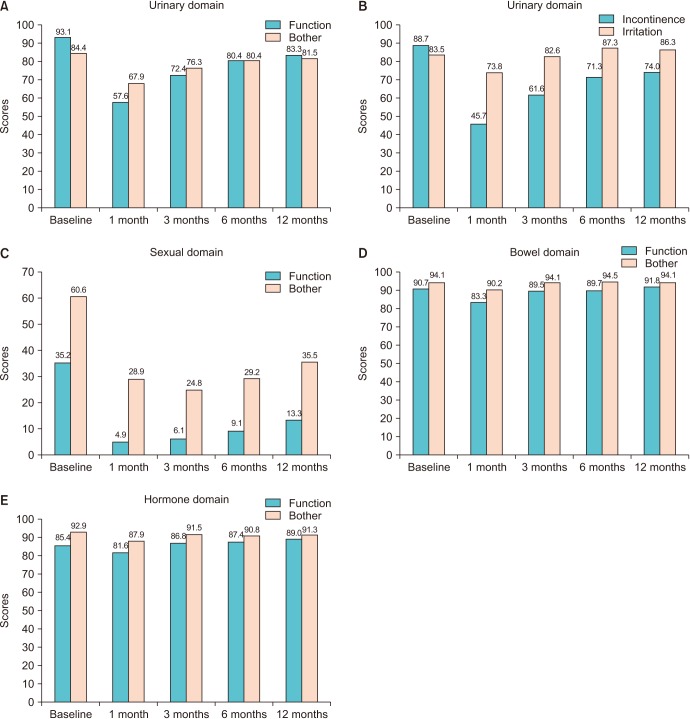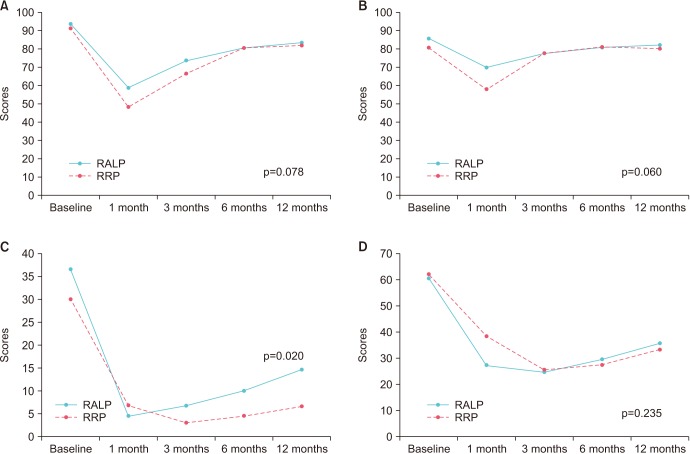Investig Clin Urol.
2018 Sep;59(5):313-320. 10.4111/icu.2018.59.5.313.
Changes in health-related quality of life after radical prostatectomy for prostate cancer: A longitudinal cohort study in Korea
- Affiliations
-
- 1Department of Urology, Asan Medical Center, University of Ulsan College of Medicine, Seoul, Korea. hjahn@amc.seoul.kr
- KMID: 2419414
- DOI: http://doi.org/10.4111/icu.2018.59.5.313
Abstract
- PURPOSE
To evaluate longitudinal changes in health-related quality of life and satisfaction after radical prostatectomy for the treatment of prostate cancer in Korean men.
MATERIALS AND METHODS
Data from patients with localized prostate cancer who underwent radical prostatectomy between January 2012 and December 2013 were analyzed. Patients completed the Expanded Prostate Cancer Index Composite questionnaire at scheduled clinic visits (baseline and 1, 3, 6, and 12 months post-surgery).
RESULTS
Data from 211 men were evaluated. Urinary domain summary scores decreased postoperatively but improved over the 12-month follow-up period. Urinary function and incontinence had not recovered to baseline values at 12 months, whereas urinary bother and irritation/obstruction scores showed no differences from baseline at 12 months. Sexual function improved at each timepoint to 12 months but did not recover to baseline values; sexual bother was approximately 50% of baseline values at 12 months. Recovery of sexual function was significantly greater in patients who underwent robotic surgery versus those who underwent open surgery. At the end of the study period, 66.3% of patients were satisfied with the treatment they had received; multivariate analysis showed that only urinary function recovery was significantly associated with overall satisfaction.
CONCLUSIONS
Urinary outcomes and sexual outcomes had not returned to baseline at 12 months. Recovery of sexual function was significantly greater in patients who underwent robotic surgery. Only recovery of urinary function was significantly associated with overall satisfaction 12 months after radical prostatectomy in this cohort of Korean men.
MeSH Terms
Figure
Cited by 2 articles
-
Letter to the editor: Changes in health-related quality of life after radical prostatectomy for prostate cancer: A longitudinal cohort study in Korea
Jong Kwan Park, Myung Ki Kim, Yu Seob Shin
Investig Clin Urol. 2019;60(3):222-224. doi: 10.4111/icu.2019.60.3.222.Letter to the editor: Changes in health-related quality of life after radical prostatectomy for prostate cancer: A longitudinal cohort study in Korea
Jong Kwan Park, Myung Ki Kim, Yu Seob Shin
Investig Clin Urol. 2019;60(3):222-224. doi: 10.4111/icu.2019.60.3.222.
Reference
-
1. Sanda MG, Dunn RL, Michalski J, Sandler HM, Northouse L, Hembroff L, et al. Quality of life and satisfaction with outcome among prostate-cancer survivors. N Engl J Med. 2008; 358:1250–1261. PMID: 18354103.
Article2. Huang GJ, Sadetsky N, Penson DF. Health related quality of life for men treated for localized prostate cancer with long-term followup. J Urol. 2010; 183:2206–2212. PMID: 20399462.
Article3. Resnick MJ, Koyama T, Fan KH, Albertsen PC, Goodman M, Hamilton AS, et al. Long-term functional outcomes after treatment for localized prostate cancer. N Engl J Med. 2013; 368:436–445. PMID: 23363497.
Article4. Hamdy FC, Donovan JL. Patient-reported outcomes following treatment for localized prostate cancer: helping decision making for patients and their physicians. JAMA. 2017; 317:1121–1123. PMID: 28324073.5. Chen RC, Basak R, Meyer AM, Kuo TM, Carpenter WR, Agans RP, et al. Association between choice of radical prostatectomy, external beam radiotherapy, brachytherapy, or active surveillance and patient-reported quality of life among men with localized prostate cancer. JAMA. 2017; 317:1141–1150. PMID: 28324092.
Article6. Barocas DA, Alvarez J, Resnick MJ, Koyama T, Hoffman KE, Tyson MD, et al. Association between radiation therapy, surgery, or observation for localized prostate cancer and patient-reported outcomes after 3 years. JAMA. 2017; 317:1126–1140. PMID: 28324093.
Article7. Zhu Y, Wang HK, Qu YY, Ye DW. Prostate cancer in East Asia: evolving trend over the last decade. Asian J Androl. 2015; 17:48–57. PMID: 25080928.
Article8. Whiting PF, Moore TH, Jameson CM, Davies P, Rowlands MA, Burke M, et al. Symptomatic and quality-of-life outcomes after treatment for clinically localised prostate cancer: a systematic review. BJU Int. 2016; 118:193–204. PMID: 27087414.
Article9. Boyd LK, Mao X, Lu YJ. The complexity of prostate cancer: genomic alterations and heterogeneity. Nat Rev Urol. 2012; 9:652–664. PMID: 23132303.
Article10. Namiki S, Kwan L, Kagawa-Singer M, Tochigi T, Ioritani N, Terai A, et al. Sexual function following radical prostatectomy: a prospective longitudinal study of cultural differences between Japanese and American men. Prostate Cancer Prostatic Dis. 2008; 11:298–302. PMID: 17909566.
Article11. Chung KJ, Kim JJ, Lim SH, Kim TH, Han DH, Lee SW. Development and validation of the Korean version of expanded prostate cancer index composite: questionnaire assessing health-related quality of life after prostate cancer treatment. Korean J Urol. 2010; 51:601–612. PMID: 20856644.
Article12. Wei JT, Dunn RL, Litwin MS, Sandler HM, Sanda MG. Development and validation of the expanded prostate cancer index composite (EPIC) for comprehensive assessment of health-related quality of life in men with prostate cancer. Urology. 2000; 56:899–905. PMID: 11113727.
Article13. Wagner AA, Cheng PJ, Carneiro A, Dovirak O, Khosla A, Taylor KN, et al. Clinical use of expanded prostate cancer index composite for clinical practice to assess patient reported prostate cancer quality of life following robot-assisted radical prostatectomy. J Urol. 2017; 197:109–114. PMID: 27475967.
Article14. Parker WR, Wang R, He C, Wood DP Jr. Five year expanded prostate cancer index composite-based quality of life outcomes after prostatectomy for localized prostate cancer. BJU Int. 2011; 107:585–590. PMID: 20804482.
Article15. Penson DF, McLerran D, Feng Z, Li L, Albertsen PC, Gilliland FD, et al. 5-year urinary and sexual outcomes after radical prostatectomy: results from the prostate cancer outcomes study. J Urol. 2005; 173:1701–1705. PMID: 15821561.
Article16. Namiki S, Ishidoya S, Ito A, Kawamura S, Tochigi T, Saito S, et al. Quality of life after radical prostatectomy in Japanese men: a 5-Year follow up study. Int J Urol. 2009; 16:75–81. PMID: 19054169.
Article17. Namiki S, Kaiho Y, Mitsuzuka K, Saito H, Yamada S, Nakagawa H, et al. Long-term quality of life after radical prostatectomy: 8-year longitudinal study in Japan. Int J Urol. 2014; 21:1220–1226. PMID: 25143229.
Article18. Cho BL, Kim YS, Choi YS, Hong MH, Seo HG, Lee SY, et al. Prevalence and risk factors for erectile dysfunction in primary care: results of a Korean study. Int J Impot Res. 2003; 15:323–328. PMID: 14562132.19. Prins J, Blanker MH, Bohnen AM, Thomas S, Bosch JL. Prevalence of erectile dysfunction: a systematic review of population-based studies. Int J Impot Res. 2002; 14:422–432. PMID: 12494273.
Article20. Moreira ED Jr, Kim SC, Glasser D, Gingell C. Sexual activity, prevalence of sexual problems, and associated help-seeking patterns in men and women aged 40–80 years in Korea: data from the Global Study of Sexual Attitudes and Behaviors (GSSAB). J Sex Med. 2006; 3:201–211. PMID: 16490013.21. Malcolm JB, Fabrizio MD, Barone BB, Given RW, Lance RS, Lynch DF, et al. Quality of life after open or robotic prostatectomy, cryoablation or brachytherapy for localized prostate cancer. J Urol. 2010; 183:1822–1828. PMID: 20303100.
Article22. Yaxley JW, Coughlin GD, Chambers SK, Occhipinti S, Samaratunga H, Zajdlewicz L, et al. Robot-assisted laparoscopic prostatectomy versus open radical retropubic prostatectomy: early outcomes from a randomised controlled phase 3 study. Lancet. 2016; 388:1057–1066. PMID: 27474375.
Article23. Haglind E, Carlsson S, Stranne J, Wallerstedt A, Wilderäng U, Thorsteinsdottir T, et al. Urinary incontinence and erectile dysfunction after robotic versus open radical prostatectomy: a prospective, controlled, nonrandomised trial. Eur Urol. 2015; 68:216–225. PMID: 25770484.
Article24. Thompson JE, Egger S, Böhm M, Haynes AM, Matthews J, Rasiah K, et al. Superior quality of life and improved surgical margins are achievable with robotic radical prostatectomy after a long learning curve: a prospective single-surgeon study of 1552 consecutive cases. Eur Urol. 2014; 65:521–531. PMID: 24287319.
Article25. Ilic D, Evans SM, Allan CA, Jung JH, Murphy D, Frydenberg M. Laparoscopic and robot-assisted vs open radical prostatectomy for the treatment of localized prostate cancer: a Cochrane systematic review. BJU Int. 2018; 121:845–853. PMID: 29063728.
Article26. Seo HJ, Lee NR, Son SK, Kim DK, Rha KH, Lee SH. Comparison of robot-assisted radical prostatectomy and open radical prostatectomy outcomes: a systematic review and meta-analysis. Yonsei Med J. 2016; 57:1165–1177. PMID: 27401648.
Article27. Ficarra V, Novara G, Ahlering TE, Costello A, Eastham JA, Graefen M, et al. Systematic review and meta-analysis of studies reporting potency rates after robot-assisted radical prostatectomy. Eur Urol. 2012; 62:418–430. PMID: 22749850.
Article28. Schroeck FR, Krupski TL, Sun L, Albala DM, Price MM, Polascik TJ, et al. Satisfaction and regret after open retropubic or robot-assisted laparoscopic radical prostatectomy. Eur Urol. 2008; 54:785–793. PMID: 18585849.
Article
- Full Text Links
- Actions
-
Cited
- CITED
-
- Close
- Share
- Similar articles
-
- Letter to the editor: Changes in health-related quality of life after radical prostatectomy for prostate cancer: A longitudinal cohort study in Korea
- Radical Prostatectomy
- A Case of No Residual Cancer in Radical Prostatectomy Specimens Despite Biopsy-proven Prostate Cancer
- Health-related Quality of Life and Depression after Radical Prostatectomy or Hormonal Therapy
- The Feasibility of Radical Prostatectomy for Medication Refractory Chronic Prostatitis/Chronic Pelvic Pain Syndrome



